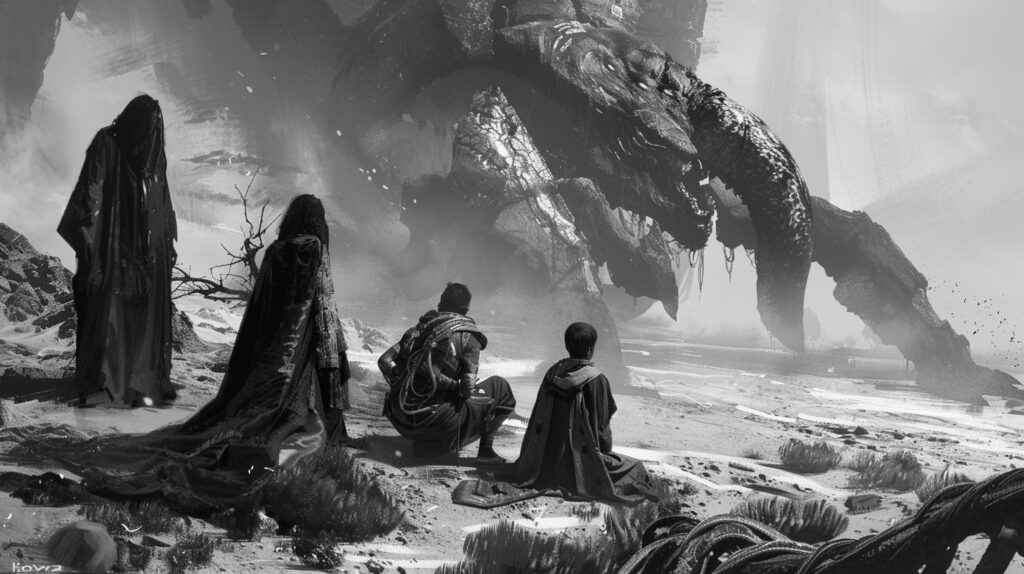The Art of Creating Believable Characters
Welcome to the exciting world of character creation! As a writer, it’s your job to breathe life into your fictional creations and make them feel real. Believable characters are the heart and soul of any story, captivating readers and keeping them engaged.
Creating believable characters is something anyone can do but it takes some understanding of character development to pull it off. But that’s why you’re here so let’s get started.
Why Believable Characters Matter
Believable characters are the driving force behind any compelling story. They are the ones who take readers on thrilling adventures, make them laugh or cry, and leave a lasting impression. When readers can connect with your characters, they become emotionally invested in the narrative, eagerly turning the pages to see what happens next.
Think about some of your favorite stories. Chances are, it’s the characters that have stayed with you long after you finished reading or watching. Whether it’s the witty and resourceful detective, the flawed but lovable hero, or the complex and mysterious antagonist, memorable characters are what make stories unforgettable.
Cracking the Character Code: Secrets Revealed
Creating believable characters may seem like a daunting task, but fear not! We’re about to let you in on some secrets to crack the character code. Here are a few essential elements to consider when developing your characters:
Developing a Strong Backstory: A character’s backstory is like the foundation of a building. It provides depth and context to their actions, motivations, and beliefs. Take the time to craft a compelling backstory that shapes your character’s past experiences, shaping who they are in the present. Check out our article on character backstory ideas for inspiration.
Giving Characters Unique Personalities: Every character should have their own distinct personality traits that set them apart from others in the story. Consider their quirks, values, and passions, and weave them into their dialogue and actions. For a comprehensive list of personality traits, visit our article on character personality traits.
The Power of Flaws: Flaws make characters relatable and human. No one is perfect, and your characters shouldn’t be either. Explore their weaknesses, fears, and insecurities to create a more authentic portrayal. For more insights, check out our article on character traits and flaws.
Balancing Strengths and Weaknesses: Alongside flaws, characters should possess strengths that help them overcome challenges. However, these strengths should never come at the expense of making them invincible. Strike a balance between their abilities and vulnerabilities to keep the story engaging and realistic. Explore more on this topic in our article on character strengths and weaknesses.
Now that we’ve cracked the character code, it’s time to put these secrets into action. In the following sections, we’ll delve deeper into building realistic personalities, creating memorable characters, and techniques for bringing them to life. Buckle up and get ready to embark on an exciting journey of character development!

Creating Believable Characters: Understanding the Basics
Creating believable characters is the foundation of any compelling story. To bring your characters to life, it’s important to focus on two key aspects: developing a strong backstory and giving characters unique personalities.
Developing a Strong Backstory
A character’s backstory is the history that shapes who they are and influences their actions and decisions throughout the story. Think of it as the blueprint of their life. A well-developed backstory adds depth and complexity to your characters, making them more relatable and realistic.
When crafting a character’s backstory, consider their upbringing, experiences, and significant life events. Delve into their family background, education, cultural influences, and any noteworthy achievements or failures. This will help you understand their motivations, fears, and aspirations, allowing you to create a more well-rounded character.
Remember, a character’s backstory doesn’t need to be fully revealed in your story. However, having a comprehensive understanding of their past will inform their present, making their actions and decisions more authentic. For ideas and prompts to develop compelling backstories, check out our article on character backstory ideas.
Giving Characters Unique Personalities
Creating unique personalities for your characters is essential for making them stand out and resonate with your readers. Each character should have their own distinct traits, quirks, and behaviors that make them memorable. After all, you don’t want your characters to feel like carbon copies of one another!
Start by thinking about what makes your character different from others. Consider their strengths, weaknesses, interests, and passions. Are they introverted or extroverted? Analytical or impulsive? By giving them specific personality traits, you’ll make them feel more authentic and three-dimensional.
To further develop your characters’ personalities, explore their flaws. Nobody is perfect, and flaws add depth and relatability to your characters. They make them more human and relatable to your readers. For tips on incorporating flaws into your characters, take a look at our article on character traits and flaws.
Creating believable characters is a journey of discovery. As you develop their backstories and unique personalities, remember to keep them consistent throughout your story. This will help your readers connect with and invest in your characters’ journey. By understanding the basics of character development, you’ll be well on your way to crafting truly compelling and memorable characters.

Building Realistic Personalities
Creating believable characters is a delicate art that involves crafting personalities that feel authentic and relatable. One key factor in achieving this is understanding the power of flaws and the importance of balancing strengths and weaknesses in your characters.
The Power of Flaws
Flaws are what make characters human and relatable. Nobody’s perfect, and your characters shouldn’t be either. Flaws add depth and complexity, making your characters more interesting and realistic. They can be physical, emotional, or even personality-related.
Think about quirks, insecurities, or bad habits that your characters might have. Maybe your protagonist is a brilliant detective but has a fear of public speaking. Or perhaps your sidekick is incredibly loyal but tends to be too trusting. These imperfections add layers to your characters and create opportunities for growth and development throughout your story.
Balancing Strengths and Weaknesses
While flaws are essential, it’s also crucial to balance them with strengths. Characters need to have skills, talents, or attributes that make them capable and interesting. These strengths can help them navigate challenges and propel the plot forward.
Consider what your characters excel at. Are they exceptionally intelligent? Skilled in combat? Highly empathetic? By giving your characters strengths that complement their flaws, you create a dynamic balance that keeps them engaging and multi-dimensional.
Remember, it’s not about creating perfect characters or characters with equal strengths and weaknesses. It’s about finding a balance that feels believable and compelling. This balance will help your characters face conflicts and obstacles in a way that feels organic and true to their personalities.
By incorporating flaws and balancing strengths and weaknesses, you can breathe life into your characters and make them more relatable to your readers. For more guidance on character development and other techniques, check out our articles on character traits and flaws and character strengths and weaknesses.
Next, let’s explore how you can add even more depth and complexity to your characters by delving into their motivations, goals, and the dynamic relationships they form throughout your story.

Creating Memorable Characters
To make your characters truly memorable and engaging, it’s important to add depth to their personalities. This can be achieved through two key aspects: motivations and goals and crafting dynamic relationships.
Adding Depth with Motivations and Goals
To create believable characters, it’s essential to understand what drives them. What are their motivations? What are their goals? These factors shape their actions and decisions throughout the story, making them more relatable to readers.
Motivations are the underlying reasons why characters behave the way they do. It can be driven by a desire for power, love, or even vengeance. Understanding your character’s motivations helps you delve deeper into their psyche and create more authentic reactions to the events in your story.
Goals, on the other hand, are the objectives that characters strive to achieve. These goals can be short-term or long-term, and they provide a sense of direction and purpose to your characters. Whether it’s saving the world or finding true love, goals add a sense of urgency and drive to the narrative.
Consider the motivations and goals of your characters, and ensure that they align with their personalities and backstories. This consistency will make their actions and decisions feel organic and believable. For more insights on developing your character’s personality, check out our article on character personality traits.
Crafting Dynamic Relationships
Another crucial aspect of creating memorable characters is to develop dynamic relationships between them. Characters don’t exist in isolation; they interact with others and form connections that shape their growth and experiences.
Think about how your characters relate to each other. Do they have a mentor-student relationship, a sibling rivalry, or a deep friendship? These relationships add depth to their personalities and provide opportunities for conflict, growth, and emotional resonance.
Dynamic relationships can be built through shared experiences, common goals, or even opposing viewpoints. These interactions allow readers to explore different facets of your characters and witness their evolution as they navigate the complexities of their relationships.
Remember to explore the conflicts and resolutions that arise from these relationships. This adds tension and drama to your story and allows for character development. For more insights on crafting compelling relationships, check out our article on character relationships and dynamics.
By incorporating motivations and goals, as well as crafting dynamic relationships, you can create characters that resonate with your readers long after they’ve finished your story.
These elements add depth and complexity, making your characters feel like real individuals with their own desires, struggles, and triumphs. So go ahead, dive deep into your characters’ minds and hearts, and bring them to life on the page.
Show, Don’t Tell
Ah, the age-old advice in the world of writing: show, don’t tell. It’s like the secret sauce that adds flavor to your characters and makes them come alive. So, how can you use this principle to reveal your character’s personality? Let’s find out!
Using Dialogue and Actions to Reveal Personality
Instead of directly telling the reader what your character is like, let their dialogue and actions do the talking. Have your character speak and behave in a way that reflects their unique personality traits. For example, if your character is witty and sarcastic, sprinkle their dialogue with clever comebacks and dry humor.
But remember, it’s not just about what your character says, but how they say it. Their voice, tone, and mannerisms can all provide insight into their personality. Is your character shy and hesitant, or bold and confident? Do they speak softly or with a booming voice? These details can help bring your character to life.
To make it even more interesting, consider conflicting traits. Maybe your character is courageous but has a fear of heights, or they are kind-hearted but have a quick temper. These contradictions can add depth and complexity to their personality.
Utilizing Character Arcs for Growth and Change
A character arc is like a rollercoaster ride for your character’s personality. It takes them on a journey of growth, change, and self-discovery. By giving your character a developmental arc, you can create a more dynamic and engaging story.
Start by defining your character’s initial traits and flaws. Then, think about the challenges they will face throughout the story. These challenges should force your character to confront their weaknesses, overcome obstacles, and ultimately, grow as a person.
For example, imagine a character who is selfish and only looks out for themselves. As the story progresses, they might encounter situations that require acts of selflessness. Through these experiences, they gradually learn the value of compassion and teamwork, transforming into a more empathetic and cooperative individual.
Character arcs can take many forms, such as the classic hero’s journey, where the protagonist undergoes a transformation from an ordinary person to a hero. Alternatively, your character’s arc could involve a downfall, where they start off strong but succumb to their flaws, leading to their own undoing. The possibilities are endless!
Remember, the key to a compelling character arc is to make it believable and earned. Show the gradual progress and setbacks your character encounters along their journey. This will make their growth feel organic and satisfying for the reader.
So, when it comes to revealing your character’s personality, remember to show, don’t tell. Let their dialogue and actions speak volumes about who they are. And don’t forget to take them on an exciting character arc, allowing them to grow and change throughout your story. Happy writing!
For more tips on character development, check out our articles on character traits and flaws and character growth and transformation.
Putting it All Together
Now that you’ve learned the secrets to creating believable characters, it’s time to put your newfound knowledge into practice. In this section, we’ll dive into case studies to analyze well-crafted characters and provide you with some tips and tricks for bringing your own characters to life.
Case Studies: Analyzing Believable Characters
One of the best ways to learn about character development is by studying existing characters in literature, film, and other forms of storytelling. Analyzing these characters can provide valuable insights into how they were crafted and what makes them believable and engaging.
Let’s take a look at a few case studies to gain inspiration and learn from the masters of character creation:
| Character | Source | Notable Traits |
|---|---|---|
| Hermione Granger | Harry Potter series | Intelligent, fiercely loyal, and resourceful |
| Tony Stark (Iron Man) | Marvel Cinematic Universe | Witty, charismatic, and flawed |
| Elizabeth Bennet | Pride and Prejudice | Independent, clever, and quick-witted |
By examining these characters and many others, you can identify the techniques used to develop their personalities, backstories, and relationships. This analysis will help you understand how to apply similar techniques in your own writing to create compelling and relatable characters.
Tips and Tricks for Bringing Characters to Life
Now that you’ve studied some case studies, it’s time to explore some tips and tricks for making your characters jump off the page and into readers’ hearts. Here are a few techniques to consider:
Character Personality Traits: Develop a list of traits that define your character’s personality. This will help you understand their motivations, reactions, and behaviors. Check out our article on character personality traits for inspiration.
Character Backstory: Craft a rich and detailed backstory for your character. This will provide depth and complexity to their persona. Need some ideas? Our article on character backstory ideas can help you get started.
Character Relationships: Explore the dynamics between your characters. Create compelling and authentic relationships that drive the plot forward. Learn more about developing strong character relationships in our article on character relationships and dynamics.
Character Arcs: Allow your characters to undergo growth and transformation throughout your story. A well-crafted character arc adds depth and emotional resonance. Discover more about character arcs in our article on character arc in storytelling.
Show, Don’t Tell: Use dialogue and actions to reveal your character’s personality rather than directly stating it. This creates a more immersive reading experience. Find out more about using dialogue effectively in our article on character dialogue and voice.
Remember, the process of creating believable characters is an ongoing journey. Continuously refine and develop your characters as you write, and don’t be afraid to experiment and take risks. With time and practice, you’ll master the art of creating characters that readers will connect with and remember long after they’ve finished your story.
Keep honing your skills, and happy character building!





























